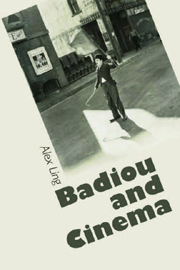Book contents
- Frontmatter
- Contents
- Acknowledgements
- Abbreviations of Frequently Cited Texts
- Introduction: Gorky's Maxim
- 1 Presenting Alain Badiou
- 2 Can Cinema be Thought?
- 3 In the Kingdom of Shadows
- 4 An Aesthetic of Truth
- 5 An Instant or an Eternity: Thinking Cinema After Deleuze
- 6 Alain Resnais and the Mise en Scène of Two
- 7 The Castle of Impurity
- Conclusion: The Future of an Illusion
- Bibliography
- Filmography
- Index
Conclusion: The Future of an Illusion
Published online by Cambridge University Press: 12 September 2012
- Frontmatter
- Contents
- Acknowledgements
- Abbreviations of Frequently Cited Texts
- Introduction: Gorky's Maxim
- 1 Presenting Alain Badiou
- 2 Can Cinema be Thought?
- 3 In the Kingdom of Shadows
- 4 An Aesthetic of Truth
- 5 An Instant or an Eternity: Thinking Cinema After Deleuze
- 6 Alain Resnais and the Mise en Scène of Two
- 7 The Castle of Impurity
- Conclusion: The Future of an Illusion
- Bibliography
- Filmography
- Index
Summary
Cinema is today the only art which is cut to the measure of the world.
Alain BadiouOf all the arts cinema is without doubt the most universal, the most immediate, and the most paradoxical. As a mass art, cinema speaks to (generic) humanity in a way that no other art is capable of doing. So too cinema's mechanical, reproductive basis means that it is available like no art before it. On top of all of this, cinema can be seen to simultaneously (re)define and confound the very notion of ‘art’, inasmuch as every film, in a single and same gesture, draws a border and erases the distinction between art and non-art. This is further compounded when we consider cinema's intimate relation to philosophy. Indeed, from its primordial connection to Plato's cave (which allegorically charts the journey of the philosopher, not the artist) through its inessential and impure being (cinema figuring an empty site of appropriation) up to its ‘unique’ artistic imperative (impurifying or idealising Ideas which are first taken from elsewhere), cinema has from the start been hopelessly entangled with philosophy. That said, cinema is foremost an art (albeit a singularly complicated art), which is to say a condition of philosophy, and the absolute separation of philosophy from its conditions is crucial lest philosophy succumb to the disaster of ‘suture’. Thus cinema is torn between two heterogeneous (and fundamentally repetitious) procedures, being at once the reproduction of art and the reproduction of philosophy.
- Type
- Chapter
- Information
- Badiou and Cinema , pp. 190 - 192Publisher: Edinburgh University PressPrint publication year: 2010



